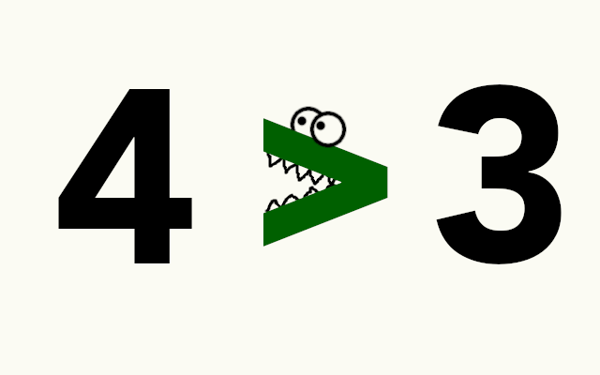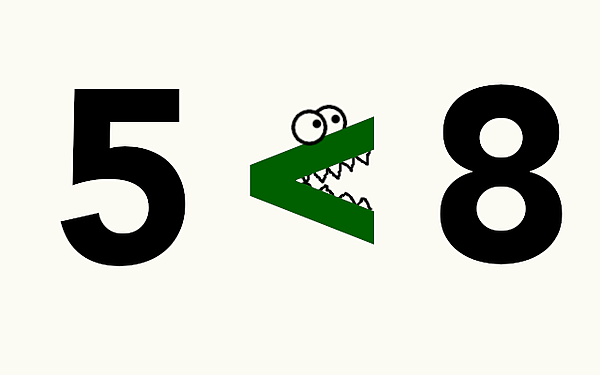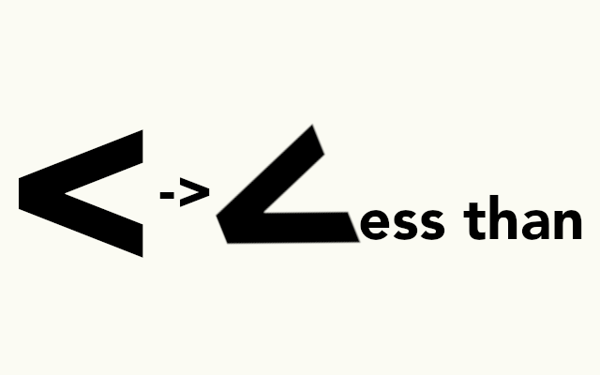Easy Way to Remember Greater Than Less Than Symbols
Inequalities are math problems that don't resolve with a clear "equals" answer—instead, they compare two things, demonstrating the relationship between them rather than showing that one is equal to another. Hence the name; "inequality" means that two things are not equal. We're all familiar with the equal sign, "=" at this point in math. But ">" and "<" are not as common, let alone "≥" and "≤". Here's a chart to cover all the inequality symbols: Symbol Meaning < Less than—the number on the left is less than the number on the right; 2 < 3 > Greater than—the number on the left is greater than the number on the right; 3 > 2 ≤ Less than or equal to—the number on the left is less than or equal to the number on the right; 2 or 3 ≤ 3 ≥ Greater than or equal to—the number on the left is greater than or equal to the number on the right; 2 or 3 ≥ 2 ≠ Does not equal—the number on the left does not equal the number on the right; 2 ≠ 3 Though the greater than and less than signs have clear meanings, they can be kind of hard to remember. All of them look similar, with the exception of the "does not equal" sign. So how can you remember them? One of the best ways to memorize the greater than and less than signs is to imagine them as little alligators (or crocodiles), with the numbers on either side representing a number of fish. The alligator always wants to eat the larger number of fish, so whatever number the mouth is open toward is the larger number. The alligator's mouth is open toward the 4, so even if we weren't sure that 4 is a bigger number than 3, the > sign would tell us. All inequality signs give us the relationship between the first number and the second, beginning with the first number, so 4 > 3 translates to "4 is greater than 3." This also works the other way around. If you see 5 < 8, imagine the < sign as a little alligator mouth about to chomp down on some fish. The mouth is pointed at the 8, which means that 8 is more than 5. The sign always tells us the relationship between the first number and the second, so 5 < 8 can be translated to "5 is less than 8." When you're working with inequalities, you can even draw little eyes on the symbols to help you remember which means which. These can be tricky to remember, so don't be afraid to get a little creative until you really have them memorized! This method is pretty simple—"less than" starts with a letter L, so the symbol that looks most like an L is the one that means "less than." < looks more like an L than >, so < means "less than." Because > doesn't look like an L, it can't be "less than." Once you've mastered the Alligator or L method, the other symbols are easy! "Greater than or equal to" and "less than or equal to" are just the applicable symbol with half an equal sign under it. For example, 4 or 3 ≥ 1 shows us a greater sign over half an equal sign, meaning that 4 or 3 are greater than or equal to 1. It works the other way, too. 1 ≤ 2 or 3 shows us a less than sign over half of an equal sign, so we know it means that 1 is less than or equal to 2 or 3. The "does not equal" sign is even easier! It's just an equal sign crossed out. If you see an equal sign crossed out, it means that the equal sign doesn't apply—thus, 2 ≠ 3 means that 2 does not equal 3. Keep these things in mind and you'll look this happy about working with inequalities. Inequalities are tricky—we're used to having a clear and concrete answer for math problems, but inequalities don't always give us that. When you're working with inequalities, keep these things in mind to help ease you through the process. Keep in mind as you're working on inequalities that they're typically asking you to solve for a relationship or to identify which symbol is appropriate rather than asking you to solve for a single number. You don't need to end up with two numbers on either side of an equal sign to be right—the answer just needs to be true. When you're working with inequalities with variables, it's important to remember that, in general, you'll be trying to isolate the variable to one side or the other. Focus on condensing numbers and canceling things out when you can, always with the goal of getting the variable alone on either side of the equation. Don't forget that performing certain actions will flip the sign. When you multiply or divide by a negative number, you need to flip the "greater than" or "less than" sign along with it. Unless you know for certain that a variable will always be positive or always be negative, don't multiply or divide an inequality by a variable. Inequalities aren't the only tricky part of math—rational numbers can also be confusing! This guide will help walk you through what a rational number is and what they look like. Ever wondered how many zeroes are in big numbers? How many zeroes are there in a billion? How about a trillion? Need to get some practice in? These 5th-grade math games can help you hone your skills! Need more help with this topic? Check out Tutorbase! Our vetted tutor database includes a range of experienced educators who can help you polish an essay for English or explain how derivatives work for Calculus. You can use dozens of filters and search criteria to find the perfect person for your needs.  What do those little sideways carat symbols mean? They're inequalities! Inequalities can be difficult to get a handle on, especially because the greater than and less than signs look so similar. But these symbols are very useful, because they help us show the relationship between numbers or equations in a way that doesn't just say that they're equal.
What do those little sideways carat symbols mean? They're inequalities! Inequalities can be difficult to get a handle on, especially because the greater than and less than signs look so similar. But these symbols are very useful, because they help us show the relationship between numbers or equations in a way that doesn't just say that they're equal.
 Not knowing what the signs mean may make your math homework feel something like this.
Not knowing what the signs mean may make your math homework feel something like this. What Are Greater Than and Less Than Signs For?
 Now we'll finally get to talk about why all these photos are of crocodiles.
Now we'll finally get to talk about why all these photos are of crocodiles. How to Remember Greater Than and Less Than Signs
Alligator Method


 Rotate your less than sign a little bit and you get an L for "less than!"
Rotate your less than sign a little bit and you get an L for "less than!" L Method
Equal Sign Method

Key Tips For Working With Inequalities
Inequalities are All About Relationships
Isolate Your Variables
Negative Numbers Change the Greater Than or Less Than Sign
Don't Multiply or Divide by a Variable—Most of the Time
What's Next?


About the Author
Melissa Brinks graduated from the University of Washington in 2014 with a Bachelor's in English with a creative writing emphasis. She has spent several years tutoring K-12 students in many subjects, including in SAT prep, to help them prepare for their college education.
Source: https://blog.prepscholar.com/greater-than-sign-less-than-sign#:~:text=One%20of%20the%20best%20ways,toward%20is%20the%20larger%20number.
0 Response to "Easy Way to Remember Greater Than Less Than Symbols"
إرسال تعليق